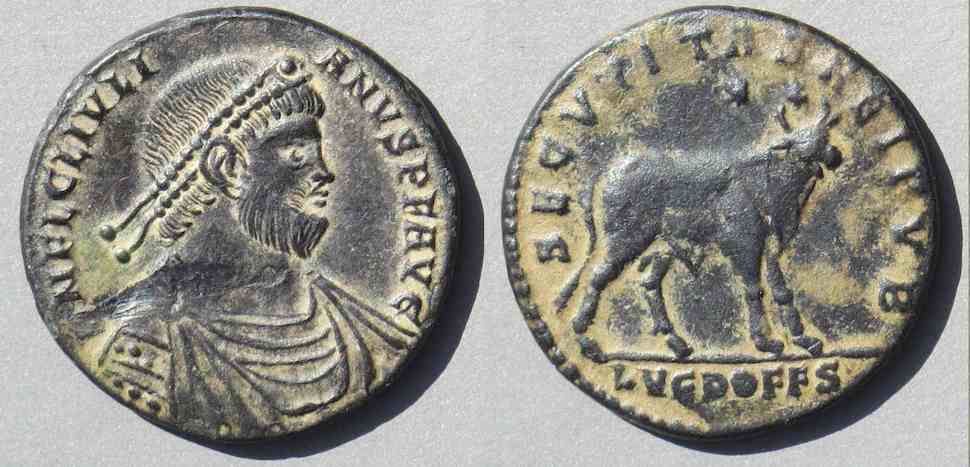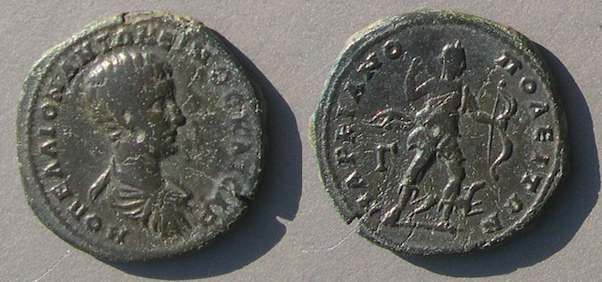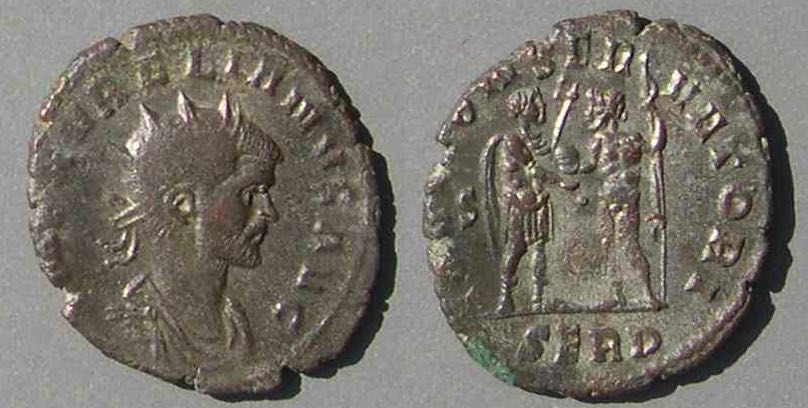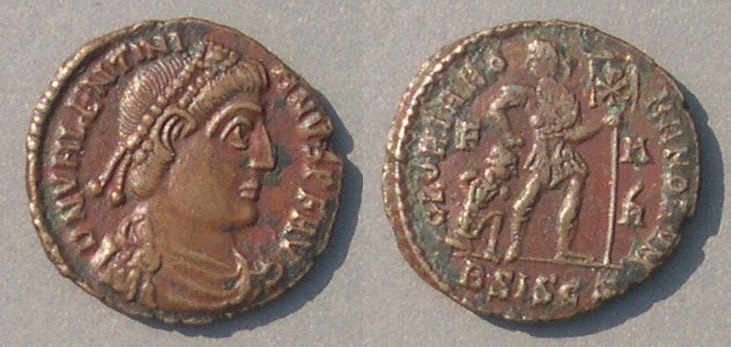Long Roman Imperial Mintmarks 
To the right: A coin of Julian II (AD 360-363) "The Apostate", minted at Lugdunum (LVGD) in the second mint workshop officina (OFF S) (Discussed below).
What's new? 2022, Feb. 17. A denarius minted at Ephesus.
Mintmarks serve to identify the mint of a coin. For example, on a US cent there is a tiny "D" if the coin is minted in Denver, which distinguishes it from coins minted in Philadephia, which are without any identifying letter. When there is only one mint, as for Roman coins during most of the republic and much of the empire, there is no need for mintmarks. But, when imperial mints began to proliferate in the mid third century AD, mintmarks began to appear. They started out short. For example "R" for Rome consistently became part of the control mark under Aurelian (270-275 AD)
Imperial mints are much different from "provincial" mints. During the first three centuries of the empire there were about 500 "Roman Provincial" coin mints and they usually named the city quite explictly. Provincial cites with long names usually had long mintmarks. For example, Marcianopolis was a prolific mint city (now in Bulgaria; it was then the largest city in Thrace). It managed to put its whole name on most of its coins.
 Diadumenian, son of the emperor Macrinus (217-218)
Diadumenian, son of the emperor Macrinus (217-218)
on a coin minted in Macrianopolis.
25 mm. 8.22 grams. 12:00 die axis.
MAPKIANO- ΠOΛEITΩN (= of Marcianopolis)
Artemis right with her bow and her dog
His name was Marcus Opellius Diadumenius Antoninus, seen here on the coin as
M OΠEΛΛION ANTΩNEINOC KAICAR
Moushmov Marcianopolis 588
BMC Thrace page 33, #39 (no photo)
I do not pursue the vast subject of provincial mintmarks.
The first Roman imperial mintmark with any claim to clarity is that of Ephesus (now in Southwestern Turkey) under Vespasian (69-79).
 Vespasian
Vespasian
Denarius. 18 mm. 3.24 grams.
PACI AVGVSTAE
EPE in lower right field for "Ephesus"
RIC 1431 page 164 plate 77.
RPC II 833
After a very long gap in time when mint marks were not used or too short to be clear, among the very common coins of Aurelian, (270-275 AD) there are a few rare coins with mintmark SERD, for Serdia (now Sophia, Bulgaria's capital and largest city).
 Aurelian, Roman emperor 270-275 AD.
Aurelian, Roman emperor 270-275 AD.
22-20 mm.
Minted at Serdica
Mintmark: SERD
IMP AVRELIANVS AVG
Reverse: IOVI CONSERVATORI
Emperor on the left in military dress holding a spear in his left
and receiving a globe from Jupiter,
naked and holding a long scepter.
RIC 265 (Serdica)
A coin reform under Diocletian (284-305) replaced the radiate denomination above (which we sometimes call an "antoninianus"). The new denomination (which we usually call a "follis") was minted in about a dozen cities, each with a decipherable, if short, mintmark, such as R for Rome, TR for Trier, ANT for Antioch, and HT for Heraclea Thracia. But, for our purposes, none of them are particularly long and we pass over them to reach the second half of the fourth century under Valentinian (364-375 AD).
Coins of Valentinian, especially those minted at Siscia, are among the most common and inexpensive Roman coins of all. This next type is easily available in high grade. Not only did coins from this period identify the mint, but many also identified the officina (a subdivision of the mint we call a "workshop") and had further "control marks" that distinguish issues. Why those particular symbols were chosen as control marks is unknown to us.
 Valentinian, Roman emperor 364-375 AD.
18 mm. 2.57 grams. 6:00 die axis.
Minted as Siscia (now Sisak, in central Croatia) with
Valentinian, Roman emperor 364-375 AD.
18 mm. 2.57 grams. 6:00 die axis.
Minted as Siscia (now Sisak, in central Croatia) with
mintmark BSISCS [the terminal symbol is similar to, but not exactly, an S]
in exergue and three control marks in the field:
F left, A right, and another special symbol below the A.
The B refers to "2", the second officina and SISC is clearly for Siscia.
What the other symbols or letters denote is uncertain.
The reverse type is GLORIA RO-MANORVM, emperor dragging captive right and holding labarum (standard with a chi-rho) in his left. The obverse legend is
DN VALENTINI-ANVS PF AVG
RIC IX Siscia 14a
RIC (Roman Imperial Coinage, volume 9) lists for Valentinian and his co-rulers from Siscia five pages of mintmarks that are about this long and complicated. This piece has six letters in exergue and, if you count the field marks, three more for a total of nine. That's a long mintmark!
During this period the mint of Rome also had some long mintmarks. Some even spelled out the officina number. SECVNDA (for "second") is the longest. (Other spelled-out officina numbers are here.)
 Valens, co-ruler of Valentinian and emperor 365-378 AD
17 mm. 2.30 grams. 6:00 die axis.
Minted at Rome with
Valens, co-ruler of Valentinian and emperor 365-378 AD
17 mm. 2.30 grams. 6:00 die axis.
Minted at Rome with
mintmark R SECVNDA
R is for Roma.
The reverse type is SECVRITAS REIPVBLICAE, Victory advancing left with wreath and palm.
The obverse legend is again
DN VALEN-S PF AVG
RIC IX Rome 24b.
That variety has eight letters in exergue. The next coin is much larger and also has eight letters.
 Julian II (The Apostate, or, The philosopher), Roman emperor 360-363 AD
27 mm. 9.07 grams.
Minted at Lyon, France, formerly Lugdunum, with
Julian II (The Apostate, or, The philosopher), Roman emperor 360-363 AD
27 mm. 9.07 grams.
Minted at Lyon, France, formerly Lugdunum, with
mintmark LVGD OFF S
where the abbrevition of "Lugdunum" is clear and the word
"Officina: is abbreviated (quite unusually--it is almost always omitted) and S refers to Secunda, the second officina.
The reverse type is SECVRITAS REIPVB, bull standing right with two stars above.
The obverse legend is
DN FL CL IVLI-ANVS PF AVG
for Flavius Claudius Julianus
RIC VIII Lugdunum 236
These are among the most explicit mintmarks in the entire Roman imperial series.
Return to the main page of this site.

 Diadumenian, son of the emperor Macrinus (217-218)
Diadumenian, son of the emperor Macrinus (217-218) Vespasian
Vespasian Valentinian, Roman emperor 364-375 AD.
Valentinian, Roman emperor 364-375 AD.